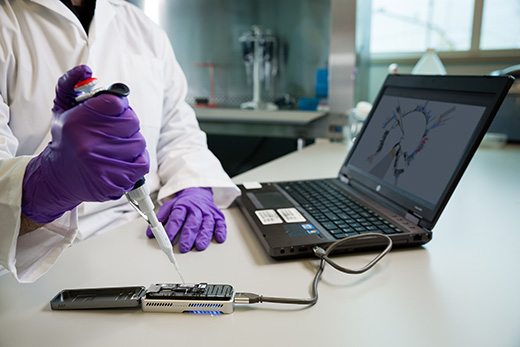Government of Canada researchers are unravelling a mystery that scientists around the world have been puzzling over since the 1940s. Funded by the federal Genomics Research and Development Initiative (GRDI), a team at the Public Health Agency of Canada (PHAC) is showing how bits of DNA called plasmids can carry antimicrobial resistance (AMR) from one species of bacteria to another.
A key mechanism
A plasmid is a small DNA molecule inside a cell that—while not part of the main chromosome—carries genes that can affect how the bacteria behaves, including whether it is resistant to antibiotics.
"The thing about plasmids is that, as they replicate, they can move from one species of bacteria to another," says Dr. John Nash, leader of the project at the PHAC's National Microbiology Laboratory. "And, since they can carry AMR genes, understanding things like how they move from one species to another, how often, in what environment this occurs, and which bacterial species can receive AMR from plasmids—all these and more are a key part of predicting and then addressing the global movement of AMR."
Problems predicting plasmids
"The thing about plasmids is that, as they replicate, they can move from one species of bacteria to another…and since they can carry AMR genes…"
While whole genome sequencing (WGS) has given researchers new insight into the characteristics of bacteria—including whether and which AMR genes it has—the technology has trouble with plasmids.
"In simple terms, WGS works by cutting DNA into small pieces, and then putting it back together in a way that allows us to see the genetic characteristics of a bacterial isolate, including whether it has AMR," says Dr. Nash, "But plasmid DNA has many sections that repeat over and over, which confuses the WGS software—so we haven't been able to get a clear picture of what's going on in there."
The MOB-suite
Until now, that is: the team led by Dr. Nash has developed a software tool they call the MOB‑suite—short for mobilome, a catch‑all term for genetic elements involved with the movement of genes.
The MOB‑suite software is able to make sense of the plasmid DNA that has been chopped up by WGS. Along with giving researchers a window into the genetic make‑up of plasmids, MOB‑suite can also predict the specific mechanism a particular type of plasmid uses to move between bacterial species.
"It's significantly more accurate than anything else out there," says Dr. Nash.
A collaborative effort
The research led by Dr. Nash is part of the 5‑year, multi‑department GRDI‑AMR project, which is funding related projects at PHAC and 4 other federal departments and agencies in a uniquely integrated approach to AMR research.
"I can't imagine something like the MOB‑suite coming out of a government lab in any other country."
"A number of the other projects are generating AMR data on bacterial isolates collected all over Canada—from the environment, food production, hospitals, even sewage outflows," says Dr. Nash. "Through the GRDI collaboration, we have access to all that data, so we can run it through MOB‑suite, and really deepen our understanding of how plasmids may be transmitting AMR genes across species. At the same time, our colleagues in other areas of the AMR project have access to the knowledge we're generating, which is really useful to things like the AMR risk management model that's being developed."
A global resource
In keeping with the Government of Canada's open source policy, MOB‑suite is available to researchers around the world, and is already being adopted by AMR researchers at other institutions in Canada and elsewhere. These include the Comprehensive Antibiotic Resistance Database (CARD) housed at McMaster University in Hamilton, Ontario—widely recognized as the global gold standard database of all known genes and genetic sequences related to AMR.
CARD co‑founder Dr. Andrew McArthur says Dr. Nash's research is making a substantial contribution. "Right now, for example, we can see that the same AMR gene may appear in 13 different pathogens, so the gene is obviously quite mobile—we just don't know how," says Dr. McArthur. "As we integrate MOB‑suite into our database, we can say precisely which plasmid is carrying which gene, and how it moves from one species of pathogen to another—information that's critical to figuring how to reduce the risk of that kind of AMR transmission."
GRDI: catalyst for innovation
As for the broader GRDI‑AMR project, Dr. McArthur says what's striking is the way it has enabled AMR research collaborations to grow, not just across the federal government, but with provincial agencies and academia. "That kind of integration and the progress it's allowing is really impressive," says Dr. McArthur. "I can't imagine something like the MOB‑suite coming out of a government lab in any other country."
In fact, Dr. Nash says he was quite humbled while attending an AMR conference in France recently, where a delegate from the French public health department spotted his name tag, and said, "John Nash! You guys wrote the MOB‑suite. We use it all the time!"
